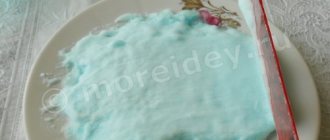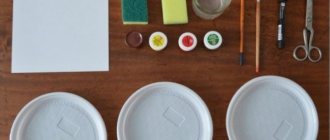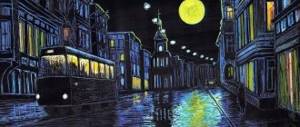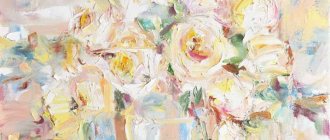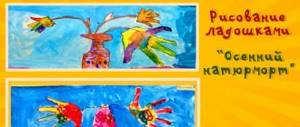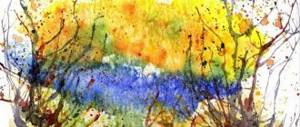Drawing for a child is an integral part of development. Through the drawing he shows his perception of the world around him, his mood, his dreams. The pointillism drawing technique for children is unconventional, and therefore very interesting to learn. The main idea is to obtain a complete image from separate points. In kindergarten, different materials are used to study pointillism - stamps, plasticine and others. We suggest mastering the method using cotton swabs and paints.
Description of the technique
Pointillism comes from the French Pointillisme, which literally means “point” (from point - dot). The technique came to us from France, where it was first used by Georges Seurat, a post-impressionist artist and founder of neo-impressionism. Thanks to the successful combination of colors, his painting “Sunday Afternoon on the Island of La Grande Jatte” became especially famous. The second striking example of pointillism is the work of Paul Signac “Harbor in Marseille”.
The peculiarity of the paintings is that they are made with separate strokes. The colors do not mix, but the eye perceives the image as a single whole. It is important to note that strokes do not always have a regular, round shape. These can be oblong lines, dots, rectangles, etc.
How to draw with children?
It’s good to start introducing pointillism to children with a short presentation of paintings made in this technique.
To arouse interest, you can start the lesson with a story about how, in skillful hands, even a simple point comes to life. At the end of the theoretical part, an example of a picture to be drawn should be shown.
When choosing an image, you need to take into account age characteristics:
- In the middle and junior groups of kindergarten (4–5 years old), children are provided with blanks with an outline for drawing using the pointillism technique. For example, coloring pages with animals (chicken, fish) or toys. Images should be as simple as possible. There is no need to use a lot of paints at once. For the first lesson, you can limit yourself to one color.
- In the older group (6–7 years old), children can independently draw an object on a given topic. First, an outline is drawn with a cotton swab, and then the middle is filled with the selected color. At this age, it is recommended to use several colors.
Unconventional drawing technique “Drawing with palms”
Natalya Grigorievna
Unconventional drawing technique “Drawing with palms”
"Drawing with palms"
The desire to create is an internal need of a child; it arises independently and is characterized by extreme sincerity. Children start drawing early; they know how and want to imagine. We, adults, must help the child discover the artist within himself, develop abilities that will help him become an individual.
Children under three years old still have difficulty handling a paint brush. And the world of colors and artistic creativity can be opened to them by their own palms and fingers. This exciting activity gives the child multifaceted tactile sensations, develops fine motor skills, and promotes speech development. The second advantage of such paints is creative freedom. By drawing with his hands, the little “master” trains his imagination, learns to think abstractly, masters the difference in colors and shapes, and manipulates paints, i.e. the baby is interested not so much in the plot of the drawing as in the process of changing the environment with the help of color.
Finger painting is a good reflex massage. There are certain points on the palms that are connected to all organs of the body. By massaging these points, you can achieve improvement.
While drawing, children and an adult mix colors in different combinations, observe and discuss how their “character” and “mood” change. At this age, there is a desire for free drawing; this develops in the child’s soul “special experiences filled with fantasy.” The easiest way to inspire a child to do manual art is to turn this process into an exciting game. For example, purple prints of open palms with fingers down can become a family of octopuses, you just need to finish drawing the eyes and mouth and draw the seabed, imprinting pebbles with your fingers. You can plant algae by dipping four fingers in paint and drawing wavy lines. And a closed palm will give an imprint of the silhouette of a fish. All that remains is to finish drawing her fins and tail. The same palms can also turn into magical flowers with finger petals - you can print an entire meadow from them! Or you can “limit yourself” to the wings of a beautiful bird.
With your palm you can draw and print any abstractions, enjoying the color, or create narrative paintings. By turning the knobs in different ways and adding missing elements to the prints, you can realize any ideas.
Children give free rein to their limitless imagination. And they usually use cheerful colors. Beauty! By giving a child the opportunity to experience everything and try it for himself, we expand children’s knowledge and creative horizons. After all, a baby stained with paint can be easily washed with soap and water and a napkin. And the desire to create, suppressed in early childhood, may never awaken.
Our works.
Materials and drawing rules
Drawing with cotton swabs is a relatively clean technique. There is no need to cover the tables with oilcloth.
Prepare materials:
- paper, cardboard (can be colored) or coloring;
- paints (watercolor, gouache);
- cotton swabs - according to the number of colors used;
- a glass of water.
Drawing rules:
- Hold the stick perpendicular to the paper.
- After dipping the cotton wool into the paint of the desired color, leave prints with short pokes.
- Fill in the outline first and gradually move from the edges to the center.
- Use a separate cotton swab for each color.
Drawing a winter landscape
In winter, learning to draw with cotton swabs will come in handy. Using the pointillism technique, you can easily and quickly depict snowflakes. For winter themes, colored cardboard is used as a basis - blue, black or gray. White color is clearly visible against a dark background.
Examples of children's drawings on the theme “winter fantasy”:
Children's work always turns out different, even if only one sample was taken. The drawing reflects the individual vision, character, knowledge, skills and abilities of the little artist.
When children master drawing with cotton swabs, it will be useful to conduct a lesson using several non-traditional techniques at once. The purpose of the lesson is to consolidate knowledge and teach the child to use available objects to obtain the desired texture and realize a creative idea.
Experienced teachers and doctors believe that drawing plays an important role in the development of children. Exercises have a positive effect on the central nervous system. They promote the development of speech skills and fine motor skills. Non-traditional techniques are notable for the fact that they make it possible to introduce very young children to art, since they do not require skillful brush strokes or pencil strokes. Mastering the technique of drawing with a cotton swab is not difficult. During the lesson, each child will be able to feel like an artist creating a work of art.
Drawing with cotton swabs, or Pointillism for children
Elena Petrova
Drawing with cotton swabs, or Pointillism for children
On the one hand, drawing with cotton swabs is a natural intermediate stage between drawing with fingers and a brush, on the other hand, it is a very unusual drawing that will certainly interest children of senior preschool and primary school age.
Drawing with cotton swabs : 1-3 years
For example, it is much easier for a child to draw with a stick than with a brush, and the stick does not need to be washed . To draw with a child of primary preschool age, you will need finger or custom gouache, paper, coloring books, cotton swabs (a lot)
and palette.
A plastic palette is needed to prevent the child from dipping a stick into a jar of gouache and taking on too much paint. And on the palette it is enough to put a little gouache of different colors, dilute it with water to a semi-liquid state, for each color you need to put its own stick . And that’s it, you can start drawing .
Show your child how to draw with a stick : draw lines or put dots. Even a little one will understand this, because this is exactly how he drew with his finger .
Drawing with cotton swabs : 3-7 years
Before offering drawing with cotton swabs to an older child , it is worth telling him about a special technique of drawing with dots , which is called pointillism . This technique was invented by the Neo-Impressionists at the end of the 19th century.
The essence of the pointillism technique is quite simple : the drawing is created using individual dots (or strokes)
different color.
In this case, the paints do not physically mix with each other, and transitions from one color to another are not created. This happens only optically, when viewing the drawing from a distance. The points can be placed close to each other or, conversely, leave more free space. This is how transitions from dark to light are created using the pointillism .
By the way, it is not necessary to draw a cotton swab and gouache . You can try using both markers and pens.
Pointillism for children
for children . When drawing, you can use a template by simply filling parts of the drawing with dots of the desired color. On the contrary, you can draw only colored outlines of objects using dots. It’s interesting to add dots to finished drawings; for example, this is how children paint snow or rain with gouache on top of a finished watercolor drawing. With children of senior preschool age who already know how to count, you can try to reproduce mosaic pictures using this technique. First, assemble a picture from the mosaic, and then draw it on a sheet , checking the correctness of the drawing.
